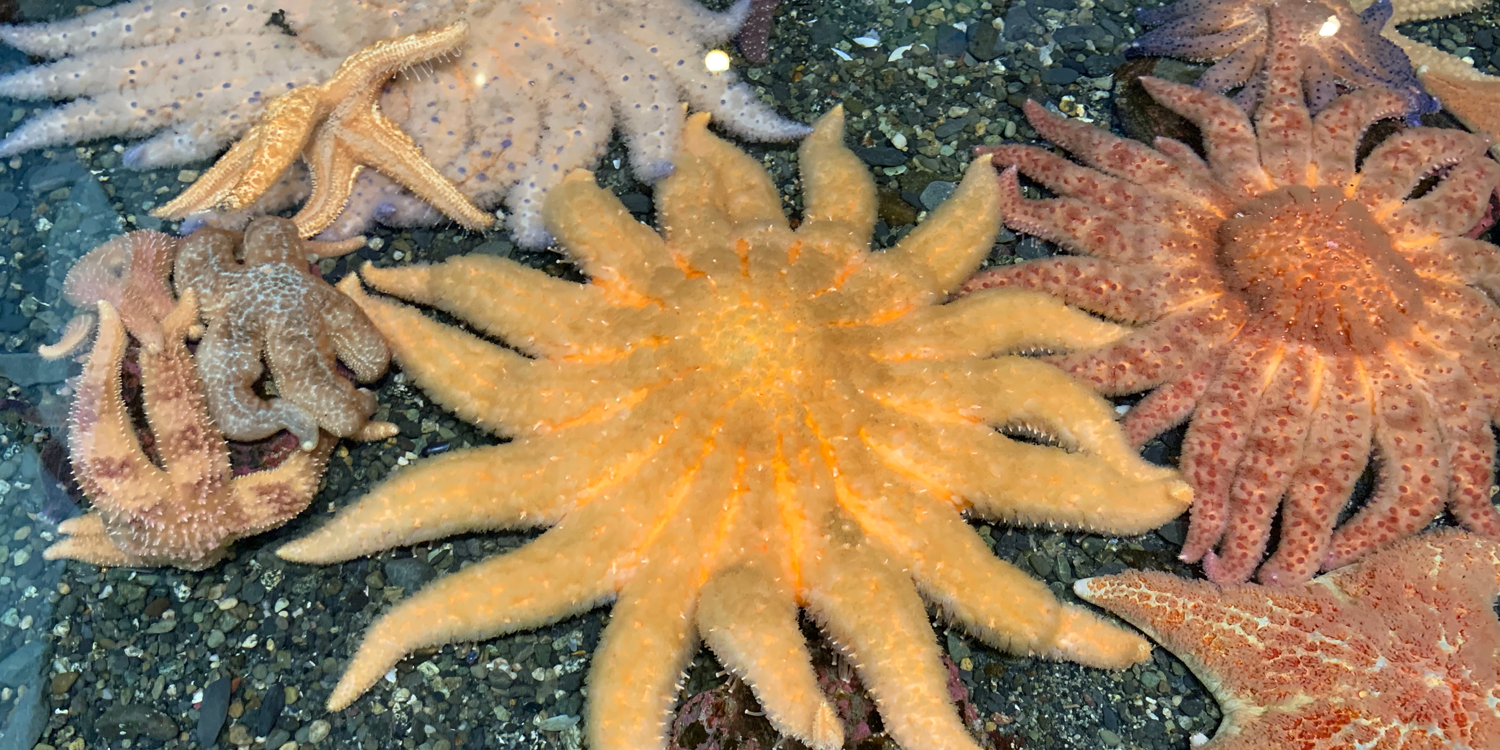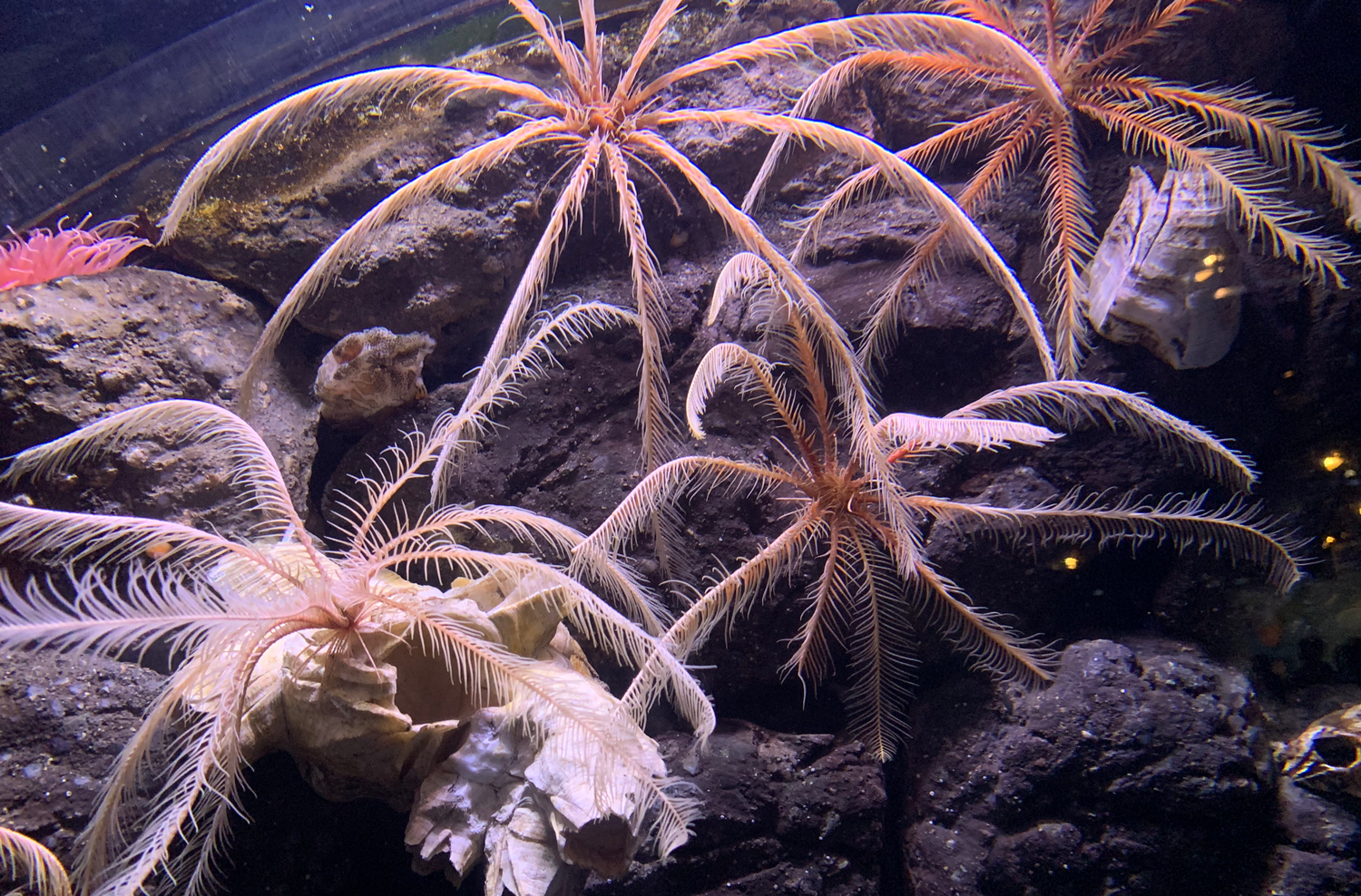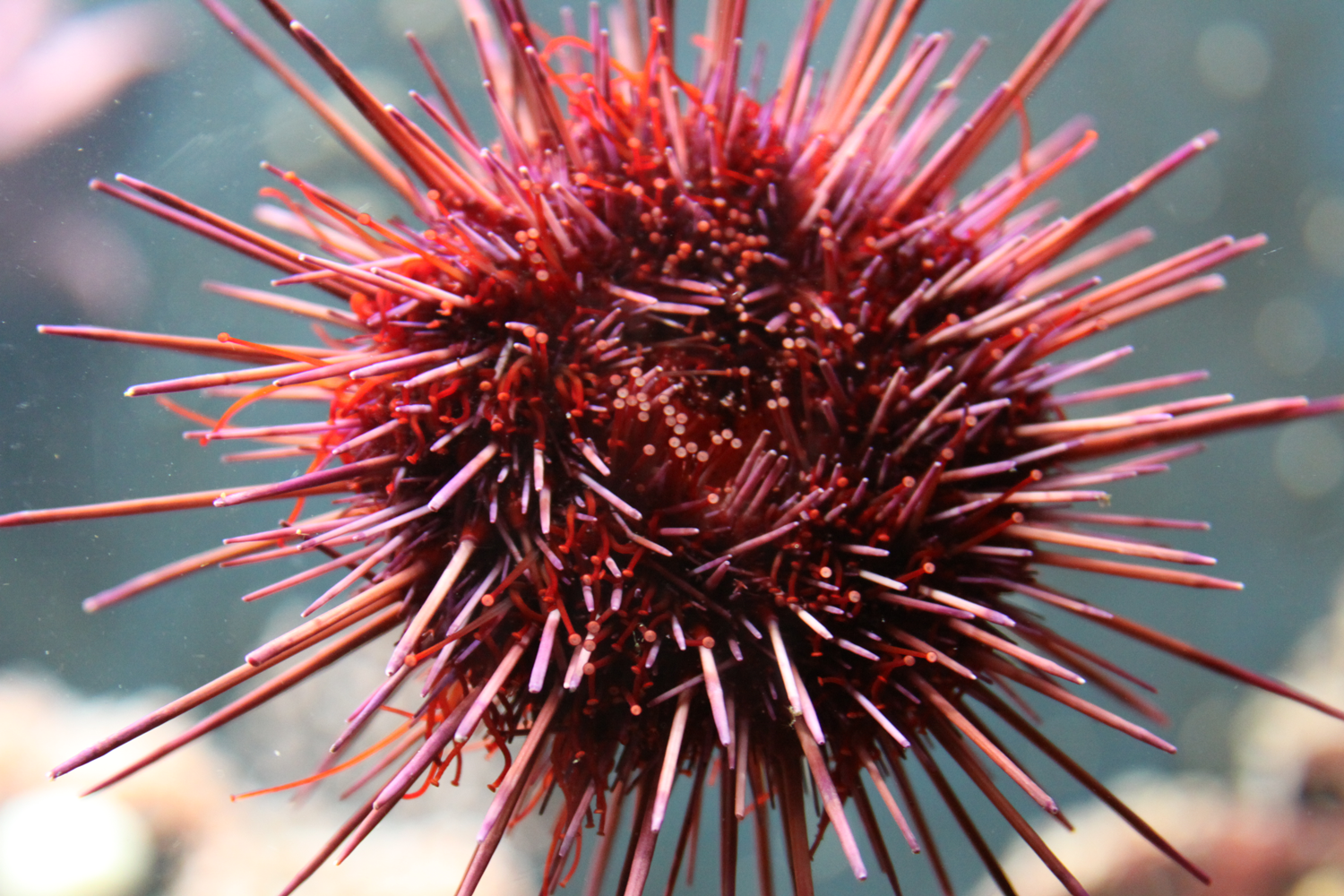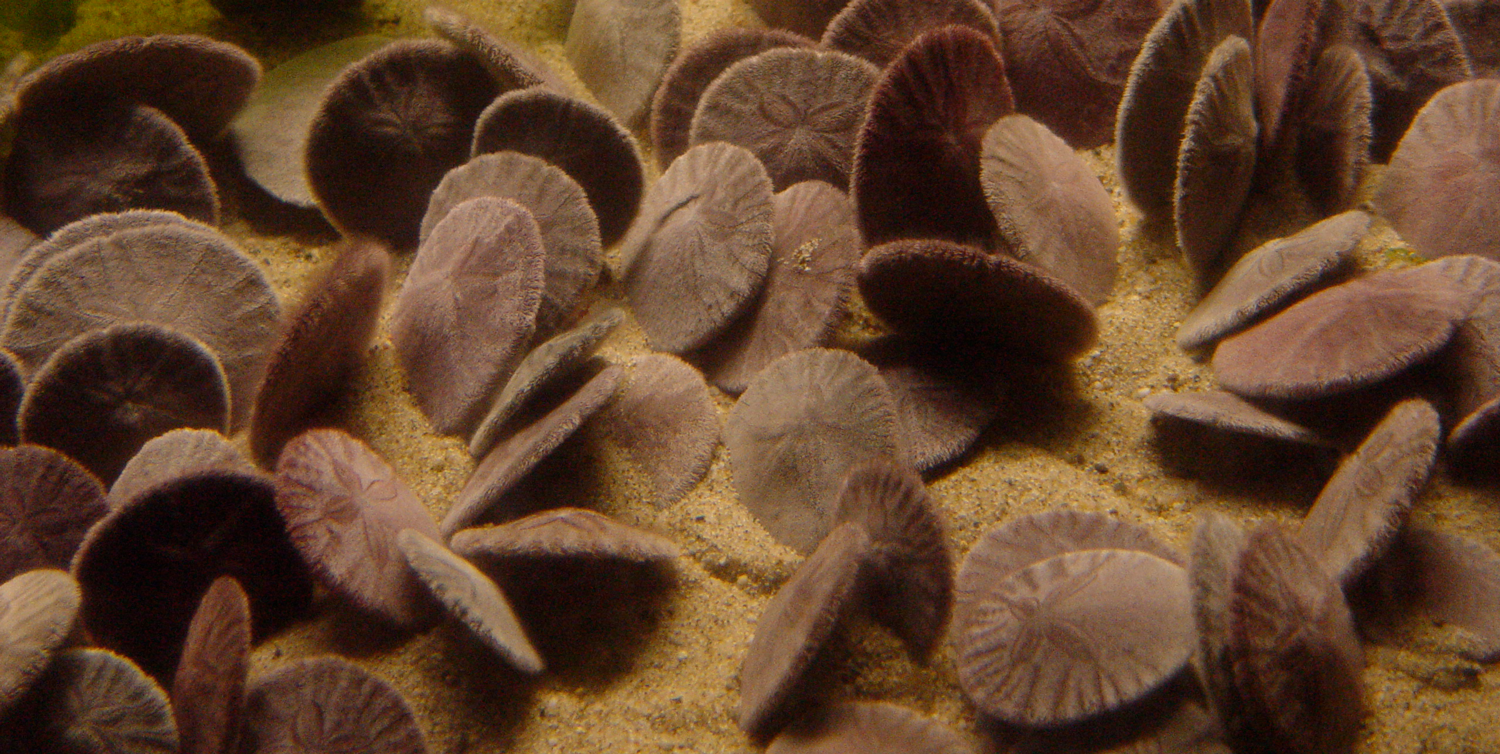Echinoderms—from Greek meaning “spiny skin”—are one of the most ancient invertebrate animal groups, with origins dating all the way back to the Cambrian explosion around 540 million years ago. Echinoderms include familiar marine life like sea stars (or, starfish), sea urchins, and sea cucumbers. They are radially symmetrical, meaning their bodies are round and arranged around a central axis, and their skin contains thick spiny plates of the mineral calcite. Echinoderms have a network of fluid-filled canals, called a water vascular system, which they use to move their bodies through hydraulic pressure. The water pressure controls special appendages called tube feet, which allow the echinoderms to move and sense the environment.

Sea stars (or, starfish) are ancient animals whose first fossils date back to the Ordovician period, 450 million years ago. They have incredible powers of regeneration, and can grow back missing arms—or, if part of the central disc is attached to a lost arm, the arm can regrow an entire new sea star.

Living seastars in an aquarium exhibit at the Alaska Sealife Center.
Modern specimen of starfish (or, seastar) (locality information unavailable). Specimen is from the teaching collections of the Paleontological Research Institution, Ithaca, New York. Maximum diameter of specimen is approximately 24 cm.
Fossil specimen of the starfish (or, seastar) Urasterella sp. from the Devonian of Tompkins County, New York (PRI 76788). Specimen is from the collections of the Paleontological Research Institution, Ithaca, New York. Longest dimension of rock surrounding specimen is approximately 6.5 cm.
Fossil specimens of the starfish (or, seastar) Henricia venturana from the Eocene Cozydell Formation of Ventura County, California (PRI 76786). Specimen from the collections of the Paleontological Research Institution, Ithaca, New York (PRI 76786). Longest dimension of larger starfish is approximately 5 cm.
Like all echinoderms, sea stars have a water vascular system that helps them move and interact with the environment. Their arms are covered with tiny tube feet, which act like suction cups and allow the sea star to move and to grasp prey. The tube feet are controlled by hydraulic pressure, and can pry the shells of bivalve mollusks apart by exerting as much as nine pounds per square inch of force. Sea star can also eject their stomachs outside their bodies to digest their food.
Conservation Connection
Although they have been successful for millions of years, sea star face a variety of challenges in today’s changing world. One species, the common sea star (Asterias rubens), is considered a bioindicator for marine ecosystems because of its sensitivity to marine pollution. Sea star are also vulnerable to high temperatures, and their feeding and growth rates suffer as water temperature increases. Sea star wasting disease, caused by a virus that causes the sea star’s body to disintegrate, has caused mass mortalities of sea star along both coasts of North America and has been tentatively linked to increasing water temperatures associated with global climate change. Because sea star are top predators, their disappearance often has profound effects on the marine ecosystem, allowing bivalve species to multiply uncontrollably and disrupt the environment.

Crinoids (or, sea lilies) feed by filtering tiny organisms and particles out of the water with their feathery arms. Some crinoids have long stalks attached to their bodies. Others are stalkless with tiny legs that allow them to crawl along the ocean floor. Stalked crinoids were most abundant during the Paleozoic (542–250 million years ago), but are much rarer thereafter. Today they live only in deep water (between 1000 and 5000 feet in depth).

Modern stalkless crinoids in an aquarium exhibit at the Alaska Sealife Center.
Fossil crinoid Actinocrinites gibsoni from the Carboniferous (Mississippian) Edwardsville Formation of Montgomery County, Indiana (PRI 78779). A feeding gastropod, Platyceras (Orthonychia) equilaterum, is associated with this specimen (PRI 78780). Specimen is from the research collection of the Paleontological Research Institution, Ithaca, New York. Length of crinoid is approximately 10 cm.
Fossil specimens of the crinoids Stellarocrinus bilineatus (PRI 49827) and Brabeocrinus christinae(PRI 76675) from the Pennsylvanian Bond Fm. of Livingston County, Illinois. Specimen is on display at the Museum of the Earth, Ithaca, New York. Longest dimension of rock is approximately 8.5 cm.
Fossil crinoid Daedalocrinus sp. from the Ordovician period (PRI 49826). Specimen is on public display at the Museum of the Earth, Ithaca, New York. Length of specimen is approximately 7.5 cm.
Lost & Found
In 1864, a young fisheries officer named Georg Sars dredged up a strange little animal off the coast of Norway. His father, the zoologist Michael Sars, realized that it resembled fossil stalked crinoids, and wrote a scientific description of it. This finding caused great excitement among marine biologists.
The discovery of living stalked crinoids played an important role in the beginnings of modern oceanography. Before these crinoids were encountered, it was not known that there was complex life in the deep ocean. The find contributed to the arguments for more active exploration of the deep sea, including the Challenger Expedition (1872–1876). As the first true scientific oceanographic cruise, this expedition laid the groundwork for the entire discipline of oceanography.

Sea urchins are spiny, round animals that are widely distributed through the world’s oceans. They are grazers, usually feeding on algae and other aquatic plants. Their rich fossil record dates back to the Ordovician, 450 million years ago. Sea urchin spines are used for defense, and some sea urchins have long, sharp spines tipped with venom, while others are shorter and blunt. The spines are attached by muscles to bumps, or tubercles, on the skeleton of the urchin. Spines usually detach after death, so both fossil and modern urchin remains often preserve only the test.

A living sea urchin on display in an aquarium exhibit at the Basel Zoo (Switzerland). View is of the oral (mouth) surface; tube feet are visible between the spines.
Modern specimen of the purple sea urchin Strongylocentrotus purpuratus from Cornwall, England (PRI 78783). Specimen is from the research collections of the Paleontological Research Institution, Ithaca, New York. Maximum diameter of specimen is approximately 12 cm.
Modern specimen of the echinoid Eucidaris tribuloides from near Key West, Florida (PRI 13410). Specimen is from the collections of the Paleontological Research Institution, Ithaca, New York. Specimen is approximately 7.5 cm in diameter.
Modern specimen of the slate pencil sea urchin Heterocentrotus mamillatus. Specimen is from the research collection of the Paleontological Research Institution, Ithaca, New York. Maximum diameter of specimen is approximately 15 cm.
Fossil sea urchin Phymosoma texanum from the Cretaceous Walnut Formation of Bell County, Texas (PRI 78781). Specimen is on display at the Museum of the Earth, Ithaca, New York. Maximum diameter of specimen is approximately 4 cm.
Fossil specimen of Phymosoma texanum from the Cretaceous Fredericksburg Group of Texas (PRI 76726). Specimen from the collections of the Paleontological Research Institution, Ithaca, New York. Specimen is approximately 4.5 cm in diameter.

Sand dollars are an evolutionary offshoot of sea urchins and arose in the Paleogene period around 50 million years ago. Their body shape has become flattened, and they have lost the sharp, spines that characterize most urchins. This new form is an adaptation for burrowing rapidly in loose sand. Sand dollar fossils are abundant in Cenozoic limestones and sandstones from southern Europe.

Numerous living sand dollars on display in an aquarium exhibit.
Fossil sand dollars belonging to the species Parascutella paulensis from the Miocene of Bordeaux, France (PRI 78782). Specimen is from the research collection of the Paleontological Research Institution, Ithaca, New York. Length of rock is approximately 20 cm.
Fossil sand dollar Encope tamiamiensis from the upper Pliocene Tamiami Fm. of Charlotte County, Florida (PRI 44095). From the collections of the Paleontological Research Institution. Maximum length of specimen approximately 7 cm.
Contents: Introduction | Microbialites | Plants | Echinoderms | Fishes | Reptiles | Opossum | Brachiopods | Mollusks | Horseshoe Crabs | Insects & Arachnids



